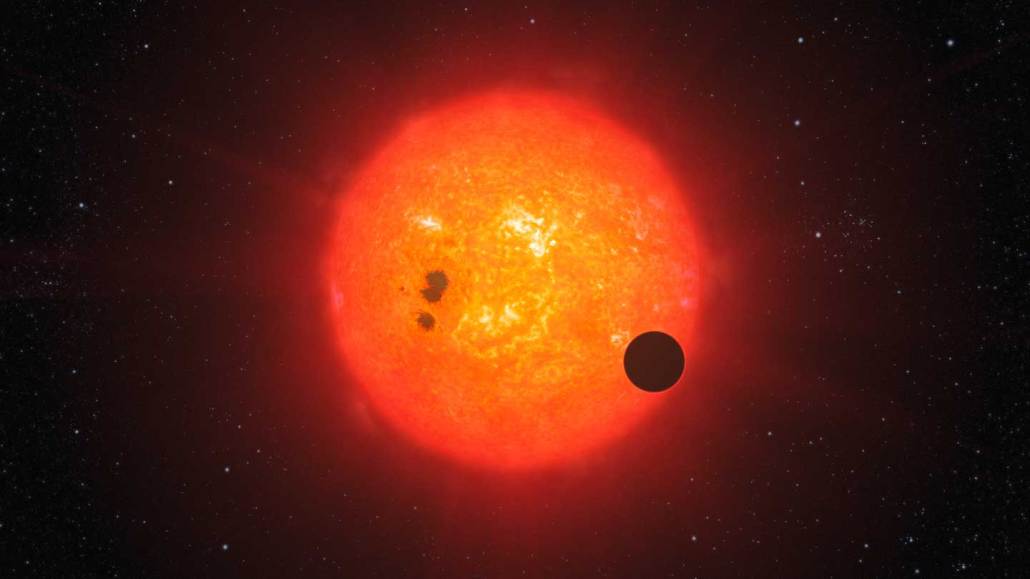
The composition of exoplanet GJ 1214b (illustrated) has vexed astronomers since its 2009 discovery. Using the James Webb Space Telescope to observe the planet could provide answers.
L. Calçada/ESO
- More than 2 years ago
BALTIMORE — When the James Webb Space Telescope was first dreamed up, exoplanets hadn’t even been discovered yet. Now the observatory is showing astronomers what it can learn about planets orbiting other stars — including the small ones.
Since its launch in December 2021, JWST had already “sniffed” the atmospheres of Jupiter-sized planets orbiting searingly close to their stars (SN: 8/26/22). Those intense worlds are interesting, but not the places where astronomers hope to look for signs of life. The telescope is now getting glimpses of atmospheres on known exoplanets of the more terrestrial persuasion, astronomers reported December 13 and 14 at the First Science Results from JWST conference.
And JWST is starting to find new rocky worlds too.
These early peeks at far-off worlds don’t yet reveal a lot about these remote locales. But researchers are buoyed by what JWST’s sharp vision in infrared wavelengths could eventually unearth about the smaller planets beyond our solar system.
“The main message is, we’re in business,” said University of Montreal astronomer Björn Benneke. “We don’t even have all the observations yet, but they are already quite exciting.”
One of the smaller planets that JWST looked at is GJ 1214b, which has frustrated astronomers since its discovery in 2009 (SN: 12/16/09). The planet is a sub-Neptune, meaning its size is somewhere between that of a rocky world like Earth and a gaseous one like Neptune.
“What the heck are sub-Neptunes?” asked astronomer Eliza Kempton of the University of Maryland in College Park. They could be balls of rock with thick hydrogen and helium atmospheres, or maybe water worlds (SN: 2/22/12). “What we’d like to do with atmospheric characterization is measure their atmospheres and see which is which,” Kempton said.
Previously, astronomers tried to observe the makeup of GJ 1214b’s atmosphere by watching how starlight filtered through it. But the atmosphere is thick and hazy, blocking astronomers’ ability to detect individual molecules in it.
Instead of watching the planet pass in front of its star, Kempton and colleagues used JWST to look for the glow of the planet right before it disappeared behind the star. And it worked: After 38 hours of observing, the researchers detected the planet’s infrared glow, Kempton said in a December 13 presentation.
There’s more work to do, but the initial data suggest the planet has a lot of chemical components, possibly including water and methane. It’s also enriched in elements heavier than hydrogen and helium.
As for knowing what kind of world GJ 1214b is, “I’d say we’re not quite there yet,” Kempton said. It could be a watery planet, she said, or a gassy planet that has lost a fair amount of its lighter elements.
The telescope also had its first look at the tantalizing TRAPPIST-1 system, Benneke said in a different December 13 presentation (SN: 12/13/17). Discovered in 2017, the system contains seven Earth-sized worlds that are probably rocky. Three of those planets might have the right temperatures for liquid water to exist on their surface, making them particularly interesting targets for JWST and other telescopes to look for signs of life.
But TRAPPIST-1 is a small, red star called an M dwarf, a type of star that is notorious for violent flares and strong radiation. For years, astronomers have debated whether planets around these stars would be hospitable to life, or if the stars would strip their planets’ atmospheres away (SN: 6/14/17).
“If the TRAPPIST planets don’t have atmospheres, then we need to move on” from M dwarfs in the search for extraterrestrial life, says astronomer Mercedes Lόpez-Morales of the Harvard-Smithsonian Center for Astrophysics in Cambridge, Mass., who was not involved in the new JWST observations.
JWST’s first look at one of those potentially habitable worlds, TRAPPIST-1g, did not reveal any clear signs of an atmosphere. But the telescope looked at the planet for only about five hours. With more observations, an atmosphere should be detectable if it’s there, Benneke said.
JWST is getting into the planet-hunting game too, said astronomer Kevin Stevenson on December 14. The telescope double-checked a potentially interesting observation from another telescope and confirmed that it had seen a rocky, Earth-sized world around a nearby M dwarf. This proves that JWST has the precision to find such worlds.
“It is an exciting result, perhaps the first discovery of an exoplanet by JWST,” said Stevenson, of the Space Telescope Science Institute in Baltimore. The planet orbits its dim star every two days, so it’s probably around 225° Celsius on the surface — likely too hot to be habitable, he says. “It’s more like an exo-Venus than an exo-Earth.”
While it’s still early days, the researchers emphasized, the forecast for planet hunting using JWST is good.
The results are paving the way for future observatories too, said astrophysicist John Mather of NASA’s Goddard Space Flight Center in Greenbelt, Md. Astronomers’ wish list for future missions includes a telescope that can dig even further into the details of potentially habitable worlds.
“If it’s not impossible,” Mather said, “let’s do it.”







